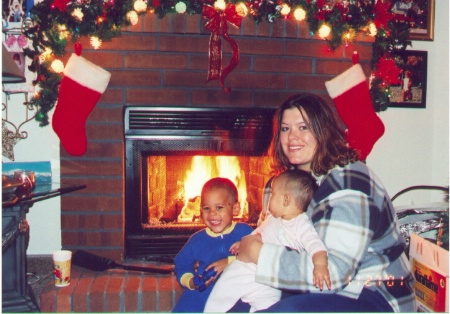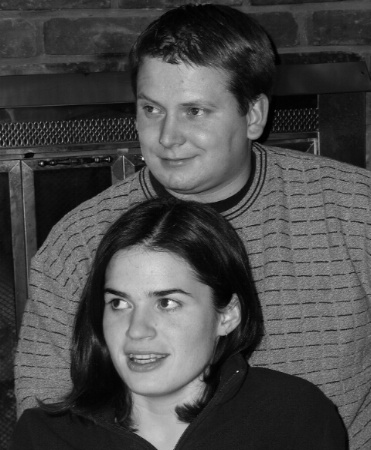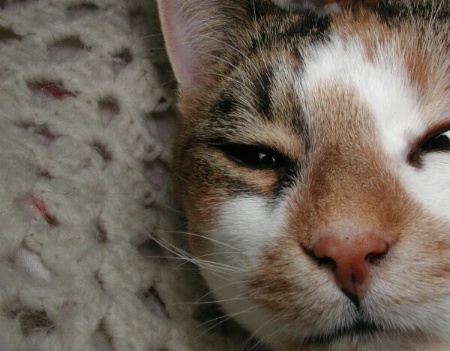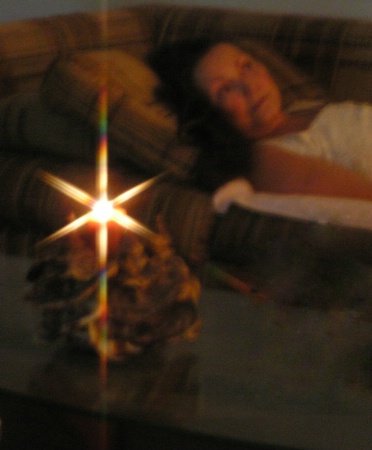
Angela McClain |
|
How to Take Christmas Photos and Show Twinkling
|
|
|
|

infront of fireplace
photo of myself and my children
Angela McClain
|
|
|
|
I can't figure out how to take a good photo in front of the Christmas tree and show the twinkling lights behind the object. I have tried no lights, dim lighting and so on. I still have not got the effect I was looking for. Seems all the photos I take are washed out to a point. Would like to catch the warm lighting of the fire and lights on the tree and still see my family.
December 04, 2001
|
|
|
Jeff S. Kennedy |
|
I'm not entirely clear as to what you want. The photo you attached looks pretty good to me. If you want to give the impression of twinkling lights then you might try a star filter.
December 04, 2001
|
|
|
John A. Lind |
|
Angela,
Your photograph does look fine compositionally; the camera angle looks decent. Keep it level to keep the fireplace looking natural (don't tilt it up or down). In looking at the shadows in the photograph, it appears you used an on-camera flash aimed directly at you. This is called "frontal" lighting. From a flash mounted on the camera and aimed directly at the subject it leave zero or nearly zero visible shadows, and is often harsh.From the description of what you want, I don't believe you can achieve it with direct, on-camera flash. Even with studio equipment, including soft boxes over the strobe(s) and separate reflector(s) for fill, the lighting setup would not be that simple. You didn't state what type of camera you are using, or the type of flash unit. If it's built-in to the camera, there's not much you can do. If it attaches to the camera, there may be some things to try, depending on its capabilities. You already know the basic issue is lighting. Take a detailed look at where all the light in this photo came from and how powerful each light source is compared to all the others:
1. Fire: it's behind you, so it cannot illuminate the part of you that's facing the camera. Even so, it can still contribute to the ambience.
2. Christmas lights: they're also behind you and cannot illumnate the part of you facing the camera either. However, I'm glad you have them turned on. They would turn out bland and flat if they weren't.
3. Flash: direct "frontal" and already discussed.4. Other: If any normal room lamps were turned on, or daylight was coming in through windows, these sources were overwhelmed by the amount of light from your flash. Suggestions:
a. If your flash mounts in the camera hot shoe and the head can be turned upward toward the ceiling, try using "bounce" for the main flash. Aim it at a point on the ceiling about halfway between the camera and subject (you and the toddlers). Hopefully your ceiling is white or very nearly white (otherwise the reflected light bounced from it will pick up the ceiling color). This will spread the light all over the room and make it much softer than aiming it directly at you. Add a table lamp with about a 75-100 watt bulb off to the left or right of the camera near the wall. This will add a slight amount of horizontal fill and put catchlights in your eyes, but it won't be from the camera direction. About 30-45 degrees between you, the camera and lamp should work. The reason for the fill: the main light from the bounced flash will come from above and will not do this.
b. If you cannot aim the flash upward, then cover it with a single layer of white handkerchief. This will diffuse and soften it some. Not as much as bounce, but it's better than nothing.
c. Use a faster film. This requires less light from your flash, makes more use of the ambient light from your christmas lights and fire. It will keep the light from the fire and the christmas lights from being overpowered and looking washed out. Don't be afraid to experiment with this some. Doing it, looking at your pictures and analyzing them for how your lighting worked out in the image will give you experience with exactly what works, and what to expect from a specific technique and setup. -- John
December 05, 2001
|
|
|
Tony Peckman |
|
For one thing, I'm gonna look for more of John L.'s advice... on anything. He's so detailed and helpful. Second, I would also, compostionally speaking, watch out for little things like putting the fire itself behind my little child's head. Makes him look like that old Lynyrd Skynyrd album cover... heads on fire. Lighting wise, cancel the flash, if you're using a point and shoot, and maybe bounce (reflect) the fires light back toward you with a foil covered piece of cardboard. John's advice of experimenting is the best thing for you and record what you did in each shot so you know what works. Have fun and don't get frustrated.
December 06, 2001
|
|
|
John A. Lind |
|
Thanks Tony . . . The reflector is also something to try . . . you won't get as much light using it, but it may work depending on your lens speed and film speed. Aluminum foil on cardboard is an old trick for making a good reflector. Tip: Crumple the foil slightly first and then flatten it back out again. This helps prevent "hot spots" in the image by spreading the reflected light out. If you try it, place it off to the side of the camera so there's about 30 degrees between reflector, subject and camera. Tony's mentioning the foil reflector trick reminded me of a very portable version I saw used recently "on location" in the field. One side of a "space blanket" has a textured foil surface. These also work well as a reflector. They're very light and can be folded up almost as small as a nylon windbreaker making them easy to carry. If the "foil" side is gold colored (instead of silver), it will "warm" the reflected light giving it a slight yellow cast . . . it's sometimes desired and sometimes not (not in this case; the fire is already a red-yellow color). Turn it over and you can use it to shade something from direct sunlight. The portability is also a downside when supporting one in use. They're not as easily propped up as a piece of stiff cardboard. "Field expedient" methods to do this are something to think about before you're in the field wanting to use it. -- John
December 06, 2001
|
|
|
N. Keith Moore |
|
Hi Angela,
I also think the suggestions that were already given were good. However, you may try softening the light on your flash and dragging or leaving the shutter open for about 1/8th second.It's worth a try if all else fails. NK
December 15, 2001
|
|
|
Angela McClain |
|
Okay, I've got the six point star filter that seems to get the effect I was looking for. If I cover the flash it seems to get the right amount of light in without overdoing it. I need to go pick up the faster speed film and give it a shot. Hopefully they come out okay. I was going to do the slower film but with two small kids its imposible to keep them still so it won't blur. I will post the results. Thanks for all the input!
December 16, 2001
|
|
|
Jaymes R. Stuart |
|
Don't go away Angela! Your shot looks really great, but here's my 2 pesos worth of advice to help you pull off the shot you want, and almost any other indoor flash shot in the average house. Get a cheapie flash unit (Vivitar 2800, $50) stick it on a cheapie off-camera bracket ($20) connect it to your camera with a PC cable ($10). Turn the external flash unit to Manual and point it upwards at 45 degrees so it bangs off your ceiling or a wall.
This will give a nice shadow softening effect. Set the on-camera flash at full. Set your f-stop one to two stops smaller than you would use with the on-camera flash alone, to accommodate the extra light. Now, the xmas twinklies? Set the shutter speed to 1/8 second or longer. If your camera has a slow-synch flash setting, use it as a starting point. This allows the camera to soak up the ambient light as well as the flash. You will need to play with this a bit to get the ratio bewteen FG/BG and twinklies you want, but your indoor shots will look 200% better using this set-up. Here's a portrait I shot hand-held using this equipment (sorry no twinklies) on an Oly C3000. Good luck. Jaymes
Digital Evangelist
January 03, 2002
|
|
|
Jaymes R. Stuart |
|
|
|
|
|

Portrait
Digital Image
Jaymes R. Stuart
|
|
|
|
Hallelujah... here's the image ;-)
January 03, 2002
|
|
|
Jaymes R. Stuart |
|
|
|
|
|

Cat
Digital Image
Jaymes R. Stuart
|
|
|
|
Here's another one, using the same setup in macro mode. You can see how it balances light beautifully. Oly C3000. Jaymes
Digital Evangelist
January 03, 2002
|
|
|
John C. Schwentner |
|
Angela, these guys are really all enlightening. I dont know if I would be good enough to handle all the technology, but Im a filter nut, and I like what jeff K said. A star filter should give you nice points of light on each bulb and is simple. I havent a good picture with my 6 point yet, but Ill try to sentd this one of Mary with a candle flame. You will get smaller points with the smaller light
June 15, 2005
|
|
|
John C. Schwentner |
|
Whoops, as usual I didnt read it all. I see you tried it, Im glad it seemed to work for you. Easy huh? And of course you can get different point filters too.
June 15, 2005
|
|
|
John C. Schwentner |
|
|
|
|
|

My Latest Flame
John C. Schwentner
|
|
|
|
.
June 15, 2005
|
|
|
|
Log in to respond or ask your own question.
|